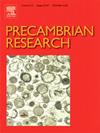西巴伊亚造山带(巴西奥弗朗西斯科克拉通)的Rhyacian (2218-2066 Ma)俯冲相关火山-沉积增生及其构造意义
IF 3.2
2区 地球科学
Q2 GEOSCIENCES, MULTIDISCIPLINARY
引用次数: 0
摘要
来自西北本文章由计算机程序翻译,如有差异,请以英文原文为准。
Rhyacian (2218–2066 Ma) subduction-related volcanosedimentary accretion in the Western Bahia Orogenic Domain (São Francisco Craton, Brazil), and tectonic implications
New evidence from the northwestern São Francisco Craton sheds light on Paleoproterozoic tectonic evolution in the Minas-Bahia Orogen. Two metavolcanosedimentary sequences—the Boqueirão de Baixo and Chapada Grande formations—record stages of a Rhyacian orogenic system, characterized through integrated stratigraphic, petrographic, geochemical, geochronological, and isotopic data. The metavolcanic rocks of the Boqueirão de Baixo Formation consist mainly of fine-grained tholeiitic amphibolites, with juvenile zircon ƐHf(t) values (+3.78 to + 5.6), which crystallized at 2218 ± 18 Ma and were metamorphosed at 2020 ± 7 Ma. The Chapada Grande Formation comprises metasedimentary rocks and calc-alkaline to ultrapotassic mafic to intermediate metavolcanics, with crystallization ages between 2096 ± 20 Ma and 2066 ± 6 Ma and evolved isotopic signatures (ƐHf(t) −18.5 to −8.84). These formations developed in a continental arc setting along the eastern margin of the Bom Jesus da Lapa Terrane, with the metasedimentary rocks recording forearc, intra-arc, and passive margin deposition. Post-collisional sinistral strike-slip shear zones subsequently generated a pull-apart basin, which favored sediment deposition and the emplacement of the Guanambi Syenite Suite. This study refines the tectonic evolution of the Minas–Bahia Orogenic System and provides new insights into Rhyacian–Orosirian orogenic belts and the early assembly of the Columbia Supercontinent.
求助全文
通过发布文献求助,成功后即可免费获取论文全文。
去求助
来源期刊

Precambrian Research
地学-地球科学综合
CiteScore
7.20
自引率
28.90%
发文量
325
审稿时长
12 months
期刊介绍:
Precambrian Research publishes studies on all aspects of the early stages of the composition, structure and evolution of the Earth and its planetary neighbours. With a focus on process-oriented and comparative studies, it covers, but is not restricted to, subjects such as:
(1) Chemical, biological, biochemical and cosmochemical evolution; the origin of life; the evolution of the oceans and atmosphere; the early fossil record; palaeobiology;
(2) Geochronology and isotope and elemental geochemistry;
(3) Precambrian mineral deposits;
(4) Geophysical aspects of the early Earth and Precambrian terrains;
(5) Nature, formation and evolution of the Precambrian lithosphere and mantle including magmatic, depositional, metamorphic and tectonic processes.
In addition, the editors particularly welcome integrated process-oriented studies that involve a combination of the above fields and comparative studies that demonstrate the effect of Precambrian evolution on Phanerozoic earth system processes.
Regional and localised studies of Precambrian phenomena are considered appropriate only when the detail and quality allow illustration of a wider process, or when significant gaps in basic knowledge of a particular area can be filled.
 求助内容:
求助内容: 应助结果提醒方式:
应助结果提醒方式:


